|
 Maldives
Maldives
Caribbean Destinations | Pacific Destinations | Indian Ocean Destinations | Pacific Newsletters | Indian Ocean Newsletters | Flora and Fauna
Map of our track & dives in Addu Atoll, Maldives. Click on a dive flag to see that dive.
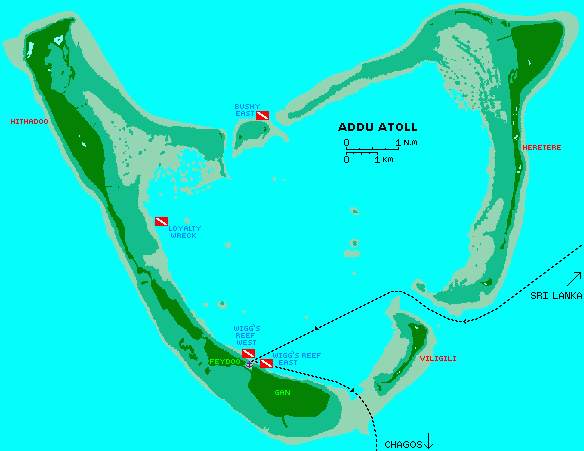 |
Language: Dhivehi, with its own unique script. English spoken well
by anyone with a secondary education or above.
Population: About 360,000, with about 27% on the small island of Male,
the capital. All are Sunni Muslims, a fairly liberal form like that
practiced in India and Indonesia.
Money: The Maldivian rufiya which is pegged to the US$, with about
Rf13 to US$1 in 2007.
Landscape: 99.9% of the Maldives is
Indian Ocean, and the land mass (made up of 26 atolls, and about 1100 islands)
is less than that of Andorra, the smallest European nation. The landscape
consists of low coral atolls with lots of coconut palms on the islands surrounding
the lagoons. There is no natural earth higher than about 4' (1.3m). The
entire Maldivian archipelago is slowly sinking as the oceans rise due to global
warming. Fantastic coral both in the lagoons and outside the atolls.
Visited: 31 March to 17 April, 2007.
Divers can get more info on our
Maldives Diving
page. Cruisers should check out our
Maldives Cruising
Information page.
A note on island names -- all of the islands and atolls in the
Maldives have at least two different names, a traditional name and an
administrative name. Also, there's the difficulty of translating to English -
just how do you spell it? This confusion is what leads us to perhaps use
different spellings throughout the site. Addu Atoll is sometimes spelled Addoo,
as on our charts, Feydoo can also be spelled Feydhoo, or even Feydu, and the
same can be said of Hithadoo (Hithadhoo, Hithadu). We try to be consistent but
spelling may vary.
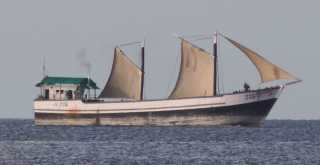
Maldivian "vedi" trading ship near Addu Atoll |
History: Very little is known for certain about the people or the
islands of the Maldives prior to the 12th century AD. It is thought that perhaps
traders from India brought forms of Buddhism and Hinduism but the archeological
evidence is unclear. Traders from the Middle East en route to the Far East
stopped here to collect cowrie shells which were used as currency throughout the
Indian Ocean from as early as the 2nd century AD. The true recorded history of
the islands begins with the arrival of Islam via an Arab trader in 1153. The
then sultan converted and ordered that all the people also convert. For the next
600 years the islands were ruled by more than 80 sultans and sultanas through
6 dynasties.
In the mid-1500's the Portuguese, eager to control more of the trade in the
Indian Ocean (they were already established in Goa, India) made an agreement
with the sultan to set up a fort in Male. In 1558 the Portuguese under Captain
Andrea Andres attacked Male and killed the sultan. The Portuguese ruled for
15 years with a stronger and stronger hand until they decreed that the population
must convert to Christianity or be killed. Fed up, and hating the Portuguese, a
Maldivian named Thakurufaanu led an attack against Male and slaughtered the
Portuguese. Thakurufaanu founded the next sultanic dynasty which ruled for
120 years. He is the national hero, and his victory is celebrated each year on
National Day.
|
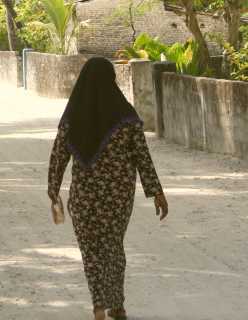
Woman in traditional robe and scarf |
For the next century the Portuguese, and even the rulers of southern India
who had originally helped Thakurufaanu, tried unsuccessfully to re-take the
Maldives. Knowing they needed external protection, the sultan agreed to a
defense treaty with the Dutch, and later with the British who were in nearby
Ceylon. In 1887 the British granted the Maldives statehood, and thus formalized
its status as a protectorate under the British Empire. By the 1930's a formal
constitution was drafted and accepted, with the sultan to be elected by a
council of the Maldivian elite.

Men relax in "jolis" in the shade, Feydoo |
World War II brought hardship to the islands as trade with Asia was
curtailed. Many people suffered malnutrition or died of starvation. After the
war, Britain agreed to oversee the foreign affairs and defense, but only in
exchange for the right to lease an island on Addu Atoll in the far south. The
1950's saw the establishment of a British Royal Air Force base on the island of Gan, with the
local population forcibly moved to neighboring islands. After a coup, and the
re-establishment of a sultanate, the new government tried to oust the British,
but the people of the southern atoll of Addu rebelled. Forces were sent in
to quell the disruption. The British stayed, but at a higher lease price. The
base was disassembled in the late 1970's, but left behind a better
infrastructure on Addu than other atolls enjoy.
The British granted the Maldives independence in 1965 and a referendum in
1968 once again abolished the sultanate. Ibraham Nasir (who had been prime
minister since the 1950's) was elected president of the new republic and held
the position for 10 difficult years, until he was forced out of office. The
Maldivian Ambassador to the UN, Maumoon Abdul Gayoom, became the new president.
An unsuccessful coup in 1988 led to massive arrests and torture of political
prisoners. Opposing political parties were outlawed and a strong-arm approach
was taken towards dissent. Although Gayoom has promoted massive international
tourism and the selling of fishing rights as the two bolsters of the Maldivian economy,
most Maldivians see that only the Gayoom friends-and-family-circle are benefiting.
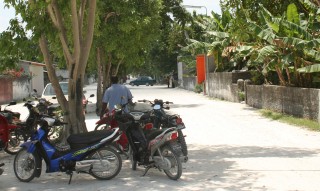
Main street (sand) in Hithadoo, Addu Atoll |
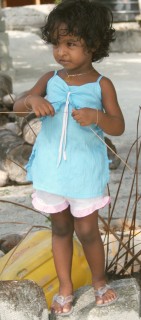
Feydoo Island child |
In 2003 a young prisoner was tortured to death and his body put on display by
the family in protest. Prisoners who voiced their protest were summarily shot.
Citizens reacted with riots and attacks on police stations, and Gayoom's
security men responded with more brutality. Finally, to appease the masses,
Gayoom paid lip-service to punishing the torturers, and in the same year (after
his own 5-year term was renewed in a one-party election) agreed to allow
opposing political parties to form. On what has become known as Black Friday,
August 13, 2004, a peaceful demonstration of former political prisoners and
reformists gathered in the capital, feeling that they were finally free to voice
their concerns without interference from the government. Without warning the
government security forces beat back the protestors, including many women and
children, and imprisoned hundreds. All across the county members of the newly
founded Maldivian Democratic Party (MDP) were also hauled from their homes,
taken to Male, and imprisoned without explanation for days or weeks. Today,
Gayoom still rules, and the fledgling MDP struggles to promote free elections in
the coming years.
When the December 2004 tsunami swept through the atolls, it could have had
worse effects were it not for the deep sea channels between the islands which
absorbed much of the waves' impacts. As it was, over 80 people lost their
lives, and over 11,000 had their homes destroyed and remain "internally
displaced persons" three years later.
Our Impressions
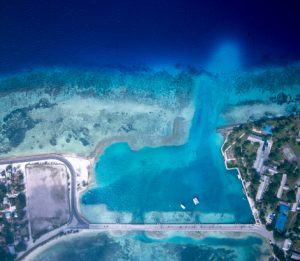
Our Addu anchorage, with Gan to the right |
(Jon) The Maldives are a chain of coral rings (atolls)
forming a north-south line along about 73°E longitude, just SW of India.
While the archipelago is over 450 miles (800 km) long, they're extremely low,
with no natural land formation rising to more than about 4' (1.3m) above the
high-tide line. They were a fun stop but the bureaucracy was a bit
frustrating. If boats go to the capital of Male, they're charged hundreds
of dollars, way out of line with other countries and much more than any other
country we've ever even heard of. But clearing in and out at the southern
end of the archipelago is free and painless, so that's what we did.
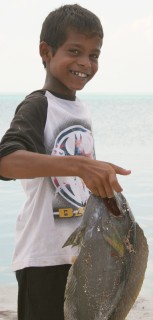
Proud fisherman! |
The Maldives has an interesting policy of encouraging tourism (to get the
hard currency) but not wanting
the tourists to mingle with the locals, presumably to keep our disruptive ideas
away. The Maldives has been run essentially as a dictatorship for 25 years
and President Gayoom's popularity was very low in 2007 (at least, in Addu).
The British, when they built the airport on Gan, also built schools and educated
the local kids. When the British left, the people of Addu were noticeably
better educated than the rest of the Maldives. Now, the new Addu-based
Maldives Democratic Party is gaining strength. Apparently, all signs of
political unrest are quickly hidden from prying foreign eyes. The British
also built all the causeways that link the southwestern islands of Addu Atoll,
the only Maldivian atoll with such easy transportation. This means that
the foreigners at the resort on Gan can freely associate with locals on the
other islands, the only place this can happen in the Maldives.

Typical curved coral walls in town |
Maldivian citizens are all Muslim - by government edict!
Walking down the streets in the afternoon was interesting - the kids would all
greet me and try out their English, but the older women wouldn't even look at
me. Men weren't afraid to return my greeting but wouldn't usually initiate
a greeting themselves.
Of course, there are always exceptions, and we met a wonderful local store
owner who introduced us to his family, showed us around, gave us advice, found
us a nice restaurant for my birthday, and even gave me a nice T-Shirt.
It's so wonderful to have that sort of local connection.
The Maldives are famous for their scuba diving and we wanted to get some in
before heading for Chagos, so we contacted the dive operators on Gan Island.
Annie is Swiss and she's a great dive guide, filling us in on local Maldivian
life as we motored to and from our dive-sites. We did 2 dives with her,
and the second one, on a WW II era tanker, was incredible. We could see the
hull from the surface, even though it lies on its side in about 100' (30m) of
water. Annie showed us some very rare and camouflaged leaf-fish, as well
as showing us over the whole wreck and then taking us through the blown-out
bottom of the tanker. Very cool.
(Amanda) Maldives is one of those countries that I didn't know
existed before we started this trip, or even before we started talking about
sailing past Australia. It may be a small country but it's right in the middle
of the Indian Ocean, and therefore a fairly important stopover for crossing to
Africa. We only went to the southernmost atoll, Addu, because we were in a time
crunch and bureaucracy makes it difficult to visit many atolls - or so we
thought when we were on our way there. We've since learned that several boats
have gotten a cruising permit from the northern-most atoll all the way to Gan
(without the right to go ashore) with little hassle. Too bad we didn't
know that at the time!
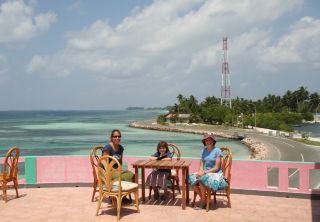
Amanda, Abby & Eliza at the new restaurant
overlooking the lagoon and causeway |
The little islands in Addu are quite cute, with their coral walls and
sand-and-shell roads (one road, connecting all the islands via the causeways, is
paved but that's it) and concrete or coral houses with beautifully swept yards.
It almost feels like being in the Tuamotus of French Polynesia again. That
wasn't quite my first impression and definitely wasn't my last, but about
halfway through our stay there it sort of worked its way into my forebrain. Of
course there are many things that are different - the religion, the language, the
Indian culture instead of the Polynesian one, and the lack of dogs, to name a few.
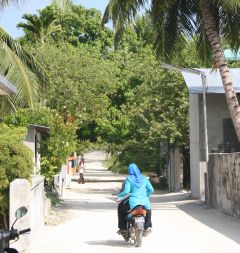
Motorbikes are the main transport |
The food is another difference. While we were there, we had three big meals
ashore. Granted, that's not many for the two-and-a-half weeks we were there, but
those meals stick out more because we weren't eating ashore every night. The
first was for Dad's birthday, but as we couldn't celebrate on the day, it turned
into an Easter lunch - though we didn't tell that to the Muslim organizers of
the meal. We got all the other yachties in the anchorage to come to a communal,
all-you-can-eat type lunch with all sorts of local food - chicken curry, fish,
rice, spicy veggie curries, rotis and chapatis. We also ate a delicious lunch
after diving one day, though it took a long time to come. The third big meal was
after being driven up to Hithadoo to clear out and stopping to see some sights
on the way. We took Mulla (our driver and the very helpful owner of the 2-Plus-1
supermarket) and his son and wife to lunch at a new restaurant on the island
north of Feydoo. The curries are delicious, and not too spicy unless you get
unlucky. Fish is very common, chicken and other meats less so. Pork is not
served.
The diving was excellent in Addu, though the days we went supposedly had the
best visibility they'd seen in months. The coral was decent, and while there
weren't too many big fish, there were a few. I wish we'd stayed longer and
visited some of the other atolls in the country, but like so many things that'll
have to wait until some point in the distant future.
You can also see my Feydhoo
(Feydoo) Walk journal entry for more of my impressions of the Maldives.
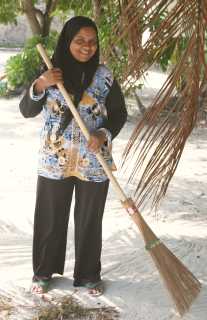
By 40 most women cover their
heads in dedication to Islam |
(Sue) I loved the slow pace of life in Addu Atoll,
watching the people walk or bicycle across the (British-built) causeway from
Feydoo Island to Gan Island for work each day. Women in long robes or
jeans and head scarves sauntered by, and men arrived by bicycle in the early
evenings to fish from the roadside. We spent many hours walking the sandy
streets on both islands, watching the white fairy terns high in the trees, or
popping in and out of the small tourist shops on Gan or the (one) small grocery
store on Feydoo.
While diving with Diverland Gan we spent travel time to and from the dive
sites talking to the dive instructor about her life for the past 15 years in
Maldives. She echoed our thoughts that the people are warm and friendly, with a
nice sense of humor. It seems that the local men who work in the resorts live a
different life from those that are fishermen or businessman. In the resorts, the
men have no qualms about putting the moves on European women, or drinking (forbidden)
alcohol that they get from the resort supplies. While women tend the homes and
children many men are away at sea for weeks at a time. Men who work on
resort islands (isolated from the towns) only get to return home about once a
year. The Maldives used to have the
highest divorce rate in the world, but in 2001 the government stopped the
unilateral (and easy) divorces whereby a man could simply say he divorced a woman
and it was done. Luckily there is no stigma on a woman to be a divorcee.
Women retain their maiden name, which is good when one could be married 3 or 4
times in one year!! Polygamy is allowed, with one man having up to 4 wives at a
time. But in practice it is rare because each wife must be treated equally --
same size house, same car, same income, etc. It gets pretty costly! Mistresses
can often be "bought" for a mobile (cellular) phone and a motor-scooter and there
is no stigma. But if the woman gets pregnant and the man refuses to acknowledge
his paternity the woman can be publicly stoned once she has recovered from
childbirth. What century are we in?
Up | Indonesia | Singapore | Malaysia | Thailand | Nepal | India | Sri Lanka | Maldives | Chagos | Seychelles | Madagascar | Mayotte
| Maldives Newsletters
| Maldives Diving
Caribbean Destinations | Pacific Destinations | Indian Ocean Destinations | Pacific Newsletters | Indian Ocean Newsletters | Flora and Fauna
| Maldives Cruising Information
Top Level:
Home |
Destinations |
Cruising Info |
Underwater |
Boat Guests |
Ocelot |
Sue |
Jon |
Amanda |
Chris |
Site Map |
Make a Comment
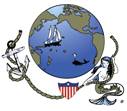 |
Lifetime
Commodores
of the
Seven Seas
Cruising
Association |
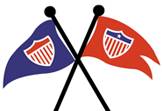 |
|
If our information is useful,
you can help by making a donation
|
Copyright © 2000‑ Contact:
Jon and Sue Hacking -- HackingFamily.com, svOcelot.com.
All rights reserved.
 Maldives
Maldives












